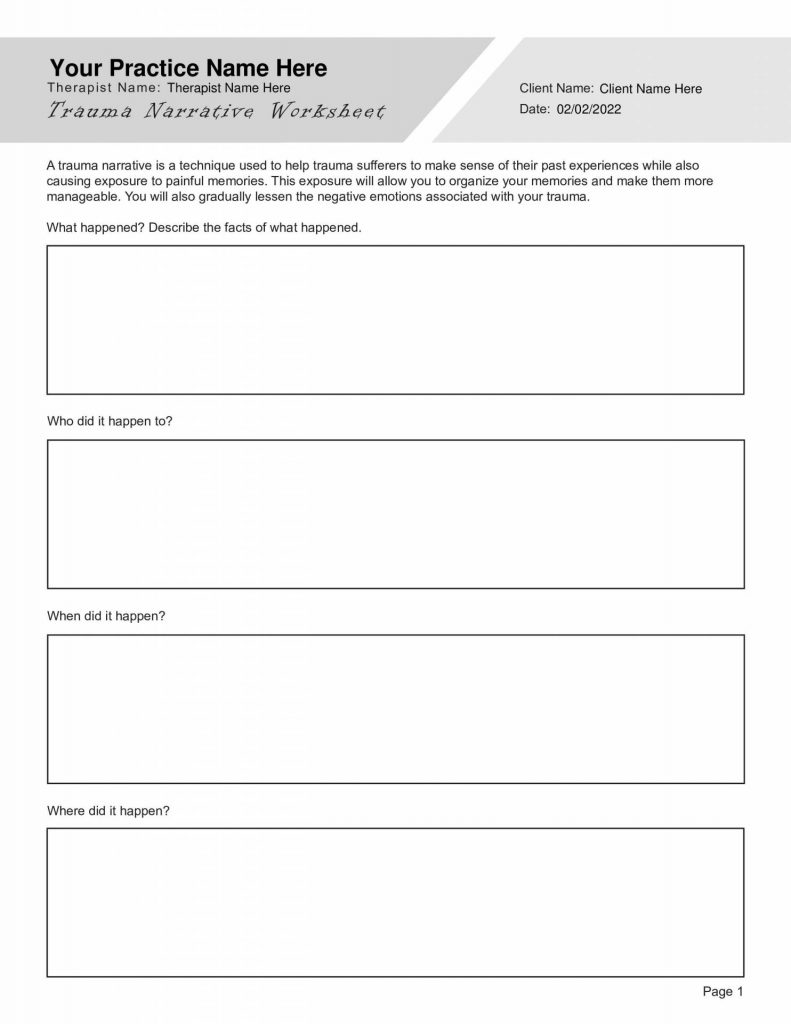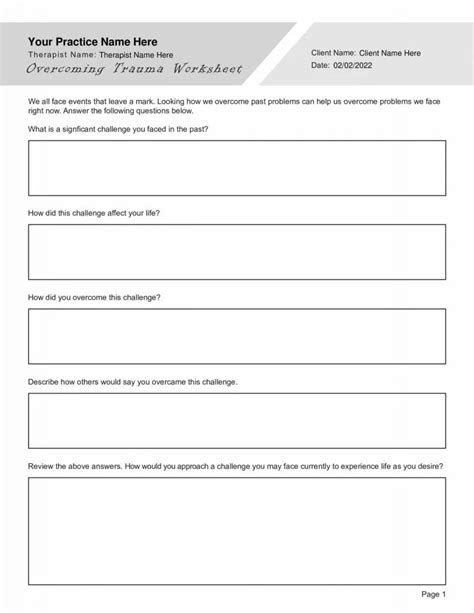5 Ways to Use a Trauma Narrative Worksheet

The journey through trauma can be challenging, but tools like a trauma narrative worksheet provide a structured path to healing. By guiding individuals through the process of organizing and articulating their experiences, these worksheets foster emotional processing and recovery. Here's how you can effectively use a trauma narrative worksheet:
1. Understanding the Process

Before diving into writing, it’s crucial to understand what a trauma narrative is. This process involves:
- Recounting the traumatic event(s)
- Exploring the thoughts, emotions, and physical sensations associated with the event
- Recognizing patterns in reactions and responses to trauma
Use the worksheet to document these elements systematically, which helps in:
- Clarifying and organizing chaotic memories
- Reducing the power of traumatic memories by externalizing them
- Providing a medium for expressing what might be difficult to voice
📝 Note: A trauma narrative worksheet isn’t a one-size-fits-all tool; it should be personalized to fit the individual’s healing process.
2. Setting the Stage for Writing

Create a safe and comfortable space for this therapeutic activity:
- Ensure privacy and minimal distractions
- Have materials ready like pens, pencils, erasers, and the worksheet
- Consider having a supportive person nearby or use this time for self-care

3. Writing the Narrative

Here’s how you can structure your trauma narrative using the worksheet:
| Section | Details to Include |
|---|---|
| Description of the Event | Details of what happened, when, where, and who was involved. |
| Immediate Reactions | Your physical and emotional responses at the time. |
| Aftermath | Changes in thoughts, behaviors, and emotions following the event. |
| Current Impact | How the trauma influences your life today. |

When writing, consider:
- Presenting the facts, feelings, and consequences
- Revisiting and revising your narrative to capture depth and detail
📝 Note: Writing your trauma narrative can be emotionally exhausting. Take breaks as needed and seek professional support if the process becomes overwhelming.
4. Reviewing and Reflecting

After completing your narrative:
- Read it back to yourself or share it with a trusted person or therapist
- Reflect on any new insights or emotions that arise
- Look for patterns, themes, or previously unrecognized impacts
This reflection can:
- Provide a sense of control over the narrative
- Highlight areas for further exploration in therapy
- Offer a different perspective on your trauma
5. Integration and Moving Forward

Integrating your trauma narrative into your life involves:
- Recognizing its significance but not letting it define you
- Using the insights gained to set new goals or change behaviors
- Acknowledging the healing process and celebrating progress
By integrating your trauma narrative into your identity, you:
- Acknowledge the past without being a prisoner to it
- Begin to write a new narrative of resilience and recovery
Using a trauma narrative worksheet is a profound step in the journey of healing from trauma. By meticulously recounting and reflecting on your experiences, you gain clarity, process emotions, and lay the groundwork for recovery. This process transforms the abstract into the tangible, allowing you to face your trauma with intentionality and care, fostering healing not just for yourself but potentially for others as you share your story.
What if writing about my trauma feels too overwhelming?

+
If the process becomes too intense, take breaks, engage in self-care activities, or talk to a therapist. Remember, healing is not a race.
Can I use a trauma narrative worksheet on my own?

+
Yes, you can start the process alone, but seeking professional guidance can enhance the effectiveness and ensure your emotional safety.
How often should I write in my trauma narrative?

+
There’s no set frequency; you can write when you feel ready. Some find daily writing helpful, while others need longer intervals between sessions.
What should I do after completing the narrative?

+
Review it, reflect on the insights, and consider sharing it with a therapist or a trusted person for support and further healing.